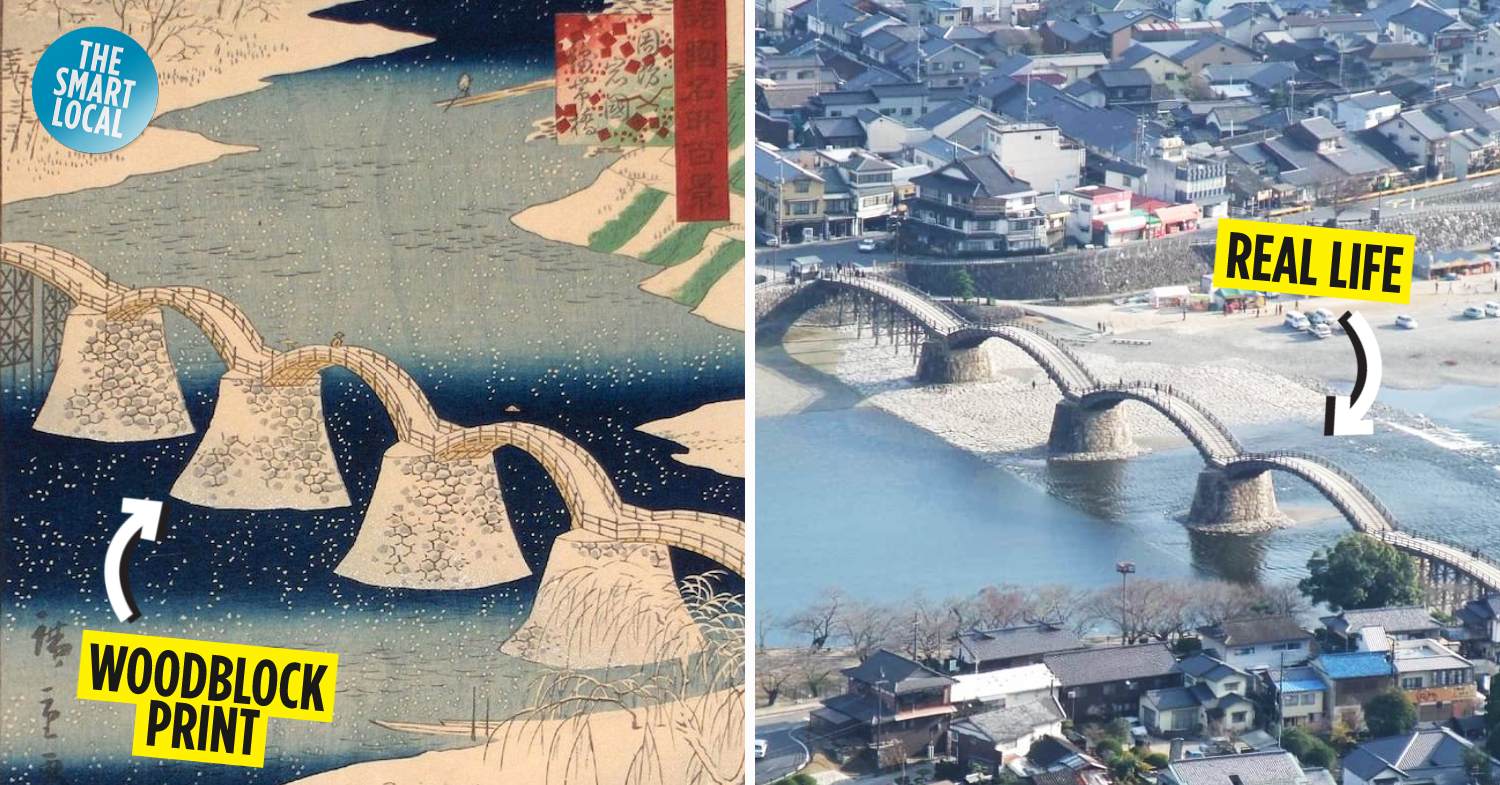Japanese woodblock prints
Japanese woodblock prints, or ukiyo-e (浮世絵), refer to a type of traditional art that was all the rage during the Edo Period. Mass-produced and distributed widely, the paintings initially focused on popular culture of the time. Hence, the majority of earlier works depicted familiar figures from the entertainment realm, such as kabuki actors and beautiful women (美人; bijin).
But by the mid-1800s, the subject matter shifted to nature and landscapes, giving birth to masterpieces we know and love today. Many of the paintings produced back then portray scenic spots in Japan that still exist now. Read on to see how much the actual locations have, or have not, changed.
1. Suō Iwakuni

Suō Iwakuni (1859) by Hiroshige II.
Image credit: Wikipedia
A part of Hiroshige II’s One Hundred Famous Views in the Various Provinces, which depicts famous places from all over Japan, Suō Iwakuni is a vertical-format print that features the present–day Kintai Bridge. In the woodblock print, you can see the magnificent arches of the bridge in its full glory, complete with a full view of Nishiki River.
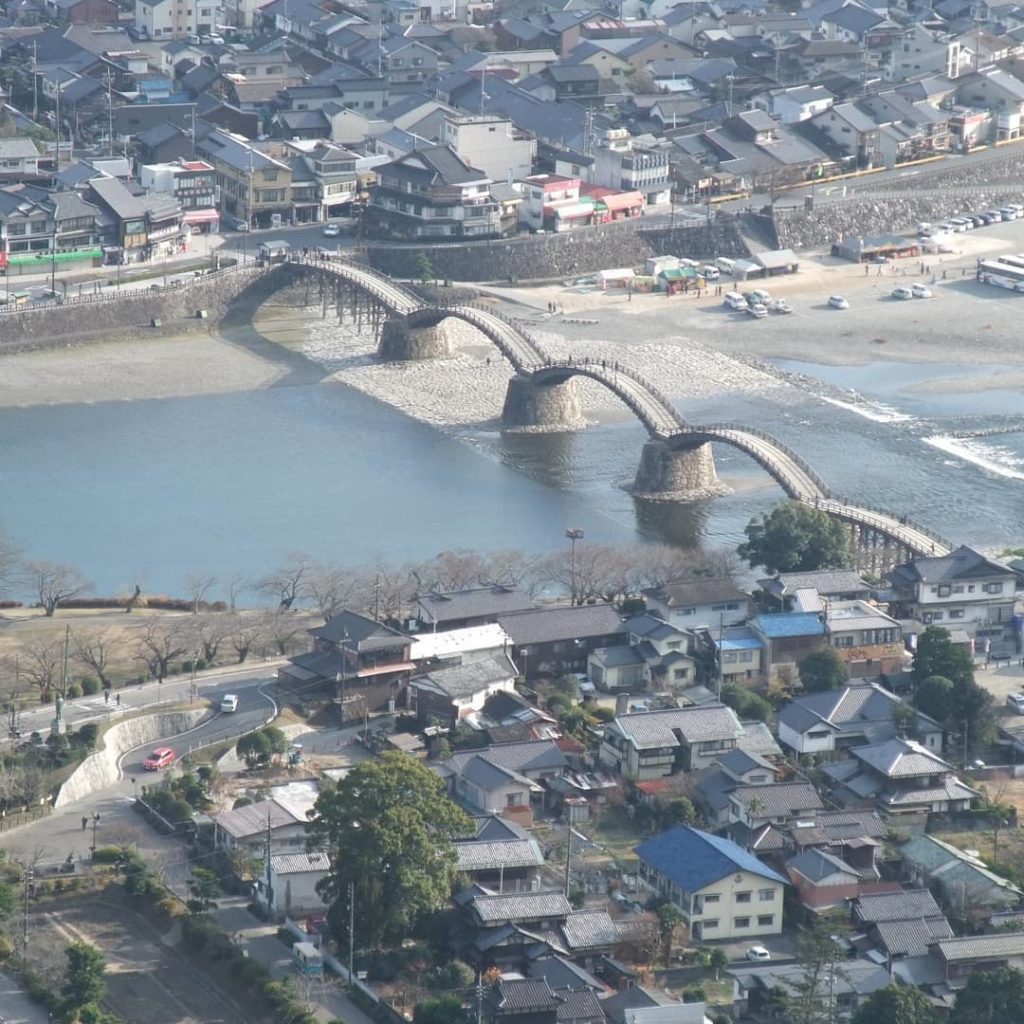
Kintai Bridge
Image credit: @yumi.wada.3363
The scenic spot is located in the city of Iwakuni, formerly known as Suō Province, in Yamaguchi Prefecture. Spanning 210m across the river, Kintai Bridge was first built in 1673 and remains a famous landmark of Iwakuni today.
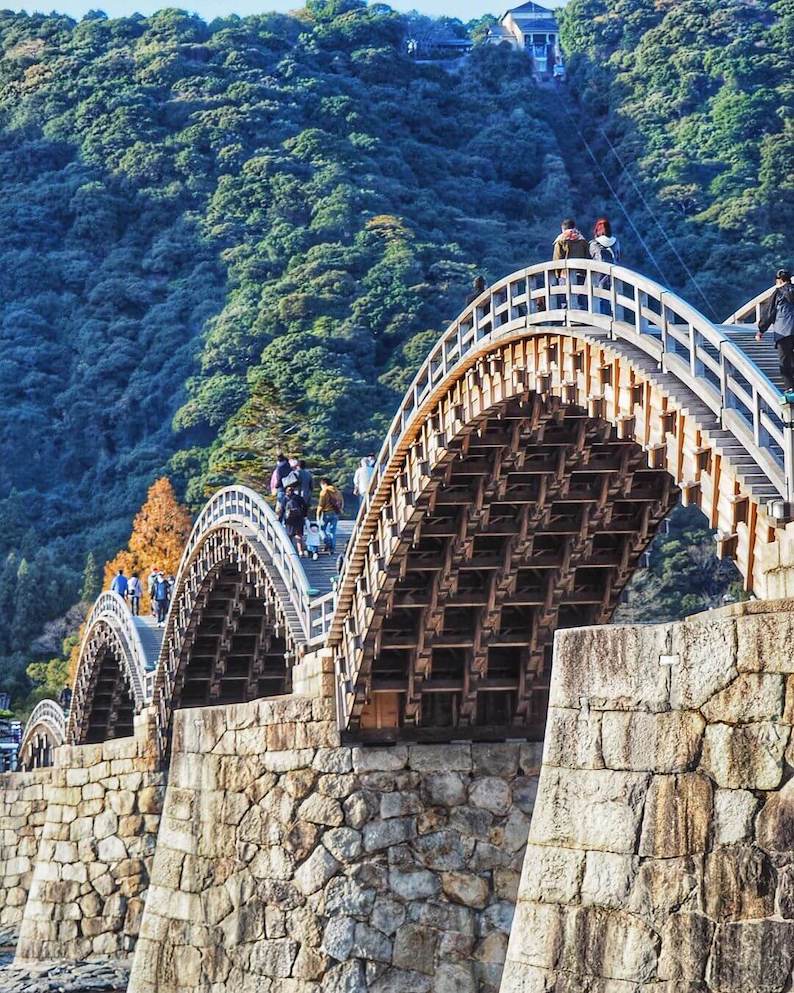
Image credit: @hikoimmersedinjapan
Back then, Kikkawa Hiroyoshi – the 3rd lord of Iwakuni – built a prototype of the current bridge, but it was soon swept away by the flood of Nishiki River. With some improvements and added reinforcements, the bridge was rebuilt in 1674. It stood for 276 years, until a typhoon in 1950 destroyed the bridge. 3 years later, a wooden bridge was constructed in its place. It wasn’t until 2002 that deteriorated wooden parts were replaced.
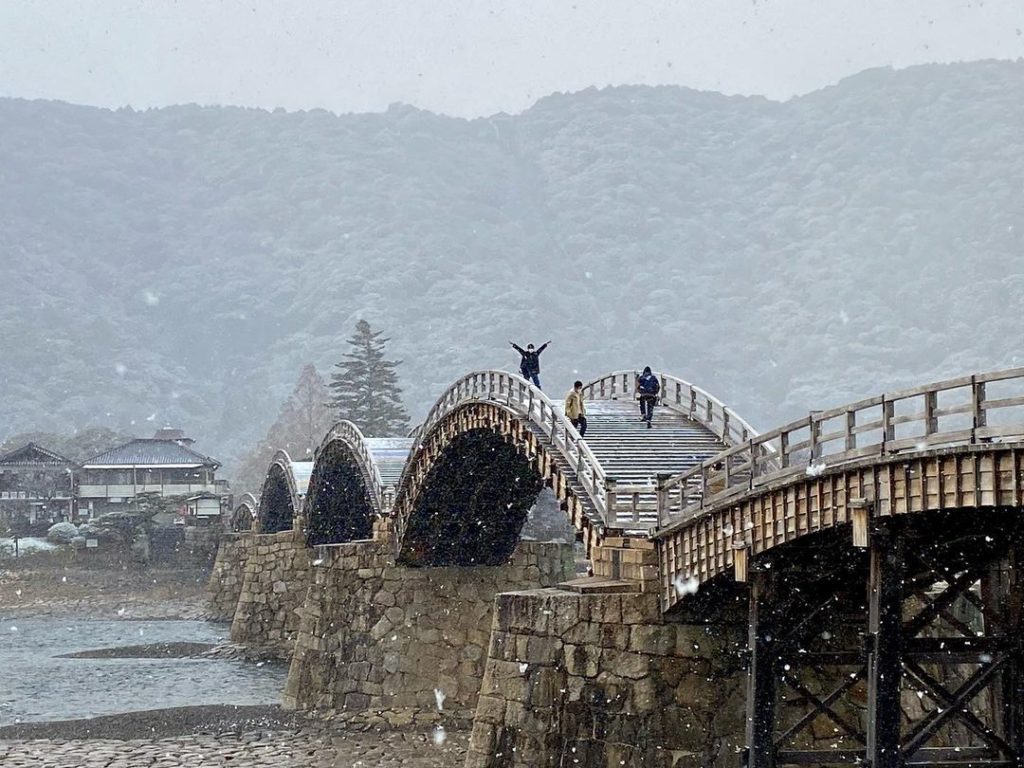
Image credit: @sweet_blossom11324
Unlike most bridges, Kintai Bridge comprises 5 arches, which makes for an unusual stroll for pedestrians. The ticket office closes in the evening, but the bridge is open for 24 hours. Visitors crossing the bridge after official opening hours will need to deposit the admission fee into a designated box near the entrance of the bridge.
Kintai Bridge
Address: Iwakuni, 741-0062, Yamaguchi
Ticket office opening hours: 8AM-5PM, Daily (Autumn-Winter) | 8AM-7PM, Daily (Spring-Summer)
Bridge opening hours: 24 hours, Daily
Admission: ¥310 (~USD2.85) for adults, ¥150 (~USD1.38) for elementary school students
Telephone: 0827-41-1477
Website
2. Night View of Saruwaka-machi
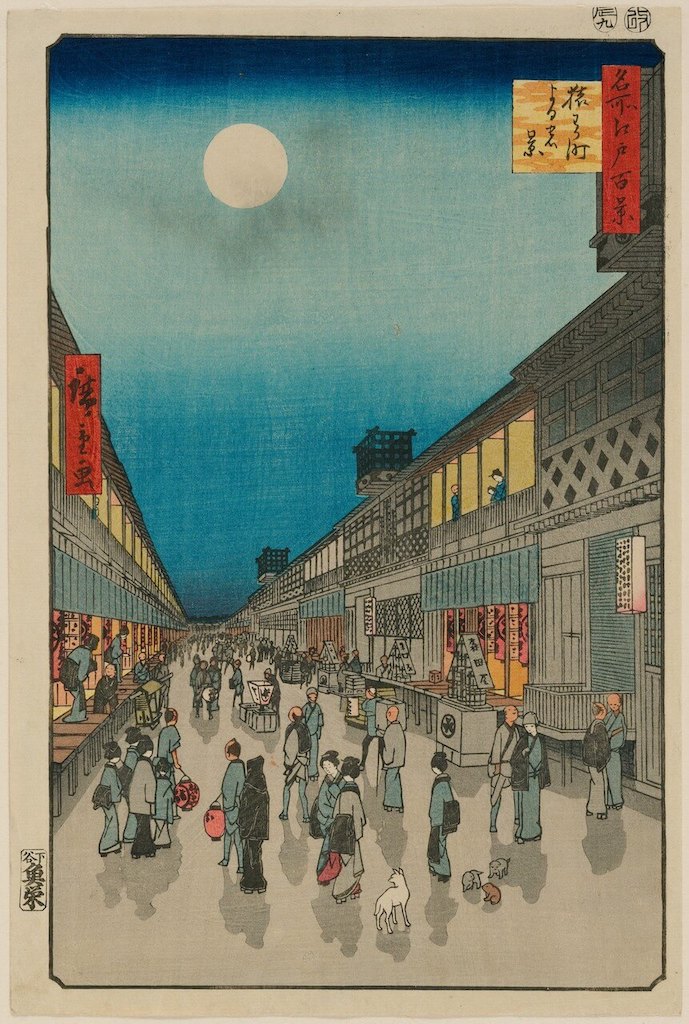
Night View of Saruwaka-machi (1856) by Utagawa Hiroshige.
Image credit: Harvard Art Museum
Revered as one of the greatest ukiyo-e artists of his time, Utagawa Hiroshige is known for woodblock prints that are characterised by a subtle and understated use of colour. The collection One Hundred Famous Views Of Edo, which is divided into 4 seasons, captures the beauty of Tokyo during the mid-1850s.
Night View of Saruwaka-machi depicts a bustling theatre town in Edo, the former name of Tokyo. During its heyday, the town was home to kabuki, puppetry, and other art theatres.
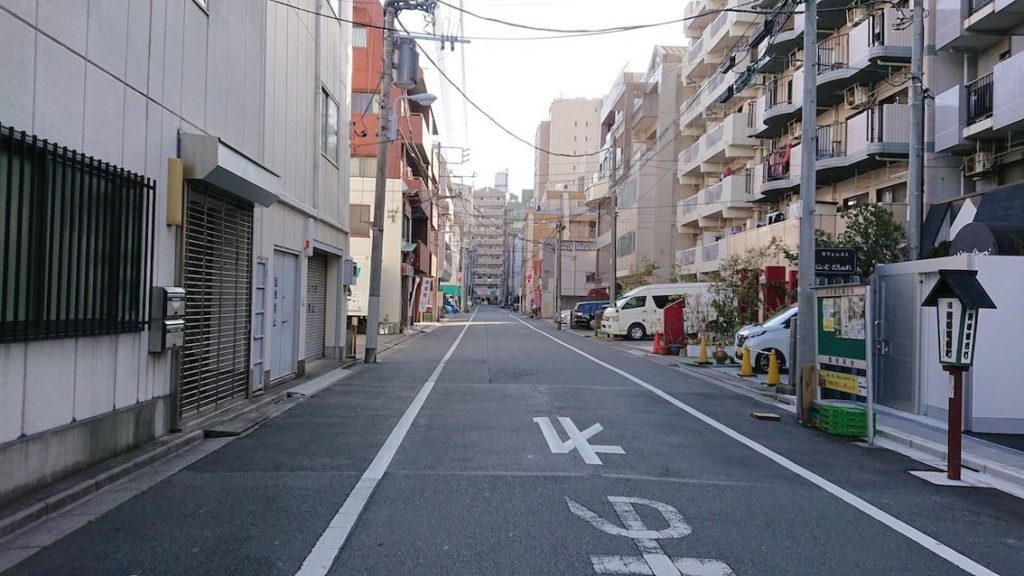
Image credit: @hjgTFGrbXA5a1Cg
The area became a major entertainment district in Edo, but its prosperity only lasted till around 1868. After that, theatres moved out one after another, which gradually brought about the decline of Saruwaka-machi.
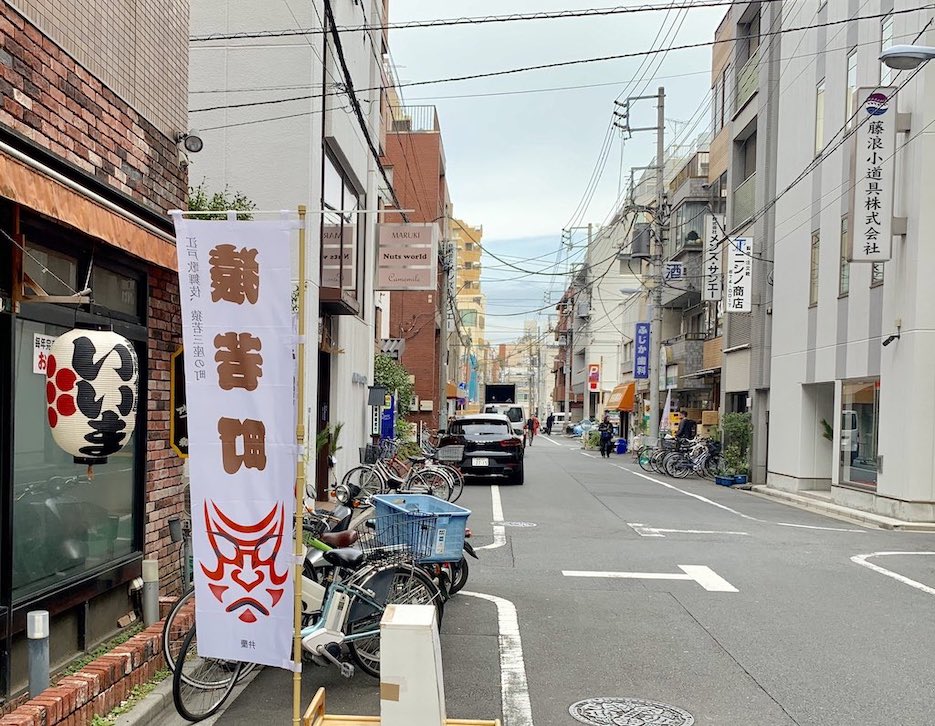
Image credit: @asakusakumasan
Today, the former entertainment district has become a nondescript residential area. Look out for signs stationed at unassuming corners of the streets that demarcate the area which the former theatre town occupied.
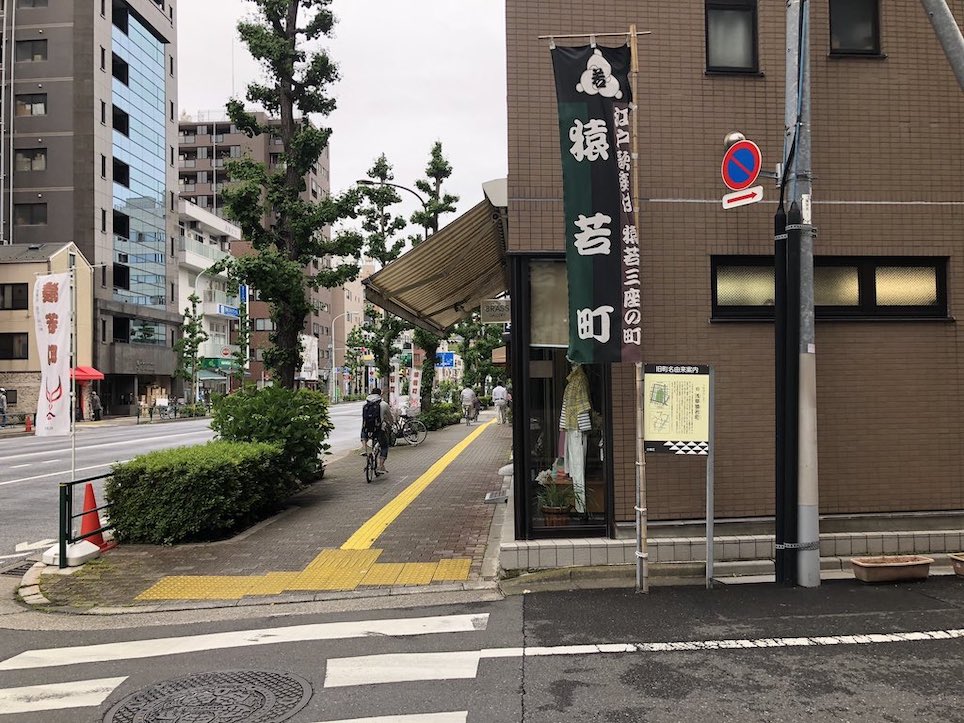
Image credit: @eatsmart21
Look closer at the painting and you’ll find shadows cast by the moonlight – it’s said that this painting inspired Van Gogh’s Café Terrace at Night. Hiroshige also used a graduation technique called atenashi bokashi (当てなしぼかし) to achieve the effect of faint clouds in the night sky.
Address: 6 Chome-18 Asakusa, Taito City, 111-0032, Tokyo
3. Rain Over Sacred Bridge
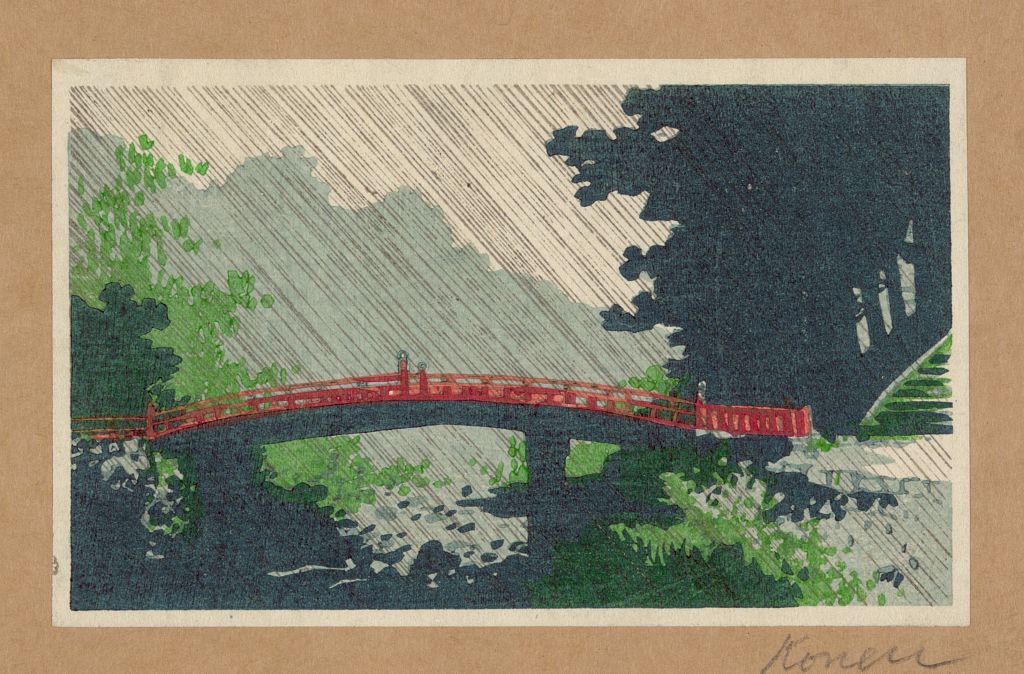
Rain Over Sacred Bridge (1900-1920) by Uehara Konen.
Image credit: Library on Congress
Located just under 2 hours by train from Tokyo, Nikko is home to numerous UNESCO Heritage sites and Shinkyō Bridge is one of them.
The subject of Uehara Konen’s Rain Over Sacred Bridge has remained unchanged over time, retaining its beauty for over 100 years. The print shows a full view of the vermilion bridge amidst heavy showers, against the backdrop of lush greenery.
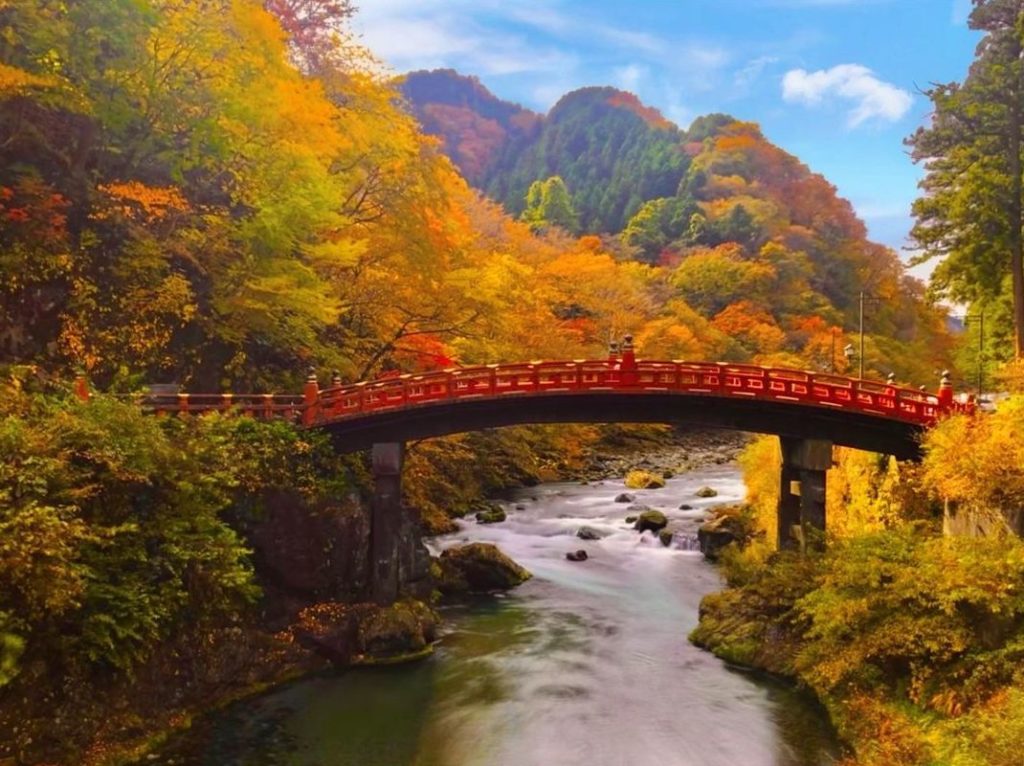
Image adapted from: @rin____167
Legend has it that at the end of the Nara Period, a monk called Shōdō Shonin and his followers tried to cross the Daiya River, but were deterred by the strong currents. Shōdō knelt down to pray with all his heart and his wish was granted by a god, who appeared and released 2 snakes to form a bridge.
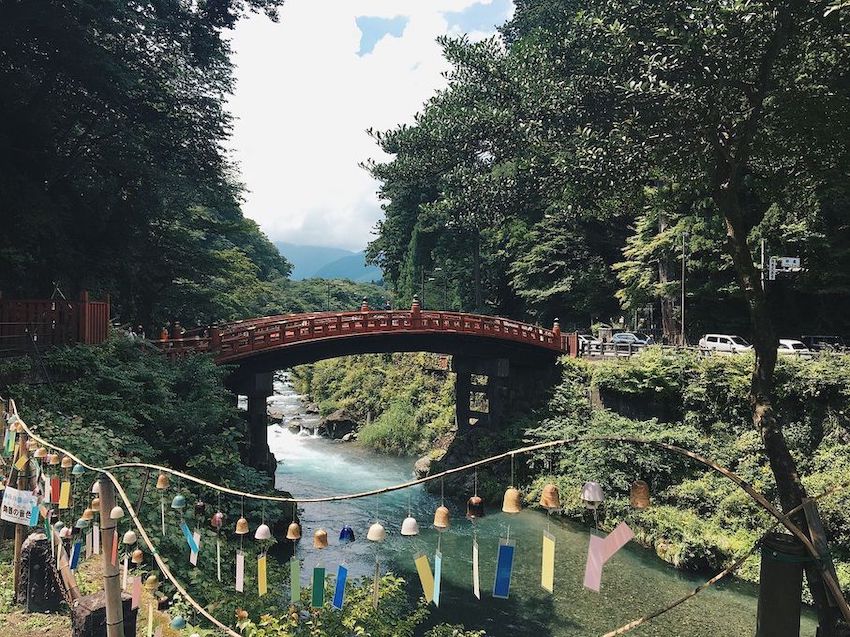
Image credit: Xiu Ting Wong
Measuring 28m long, Shinkyō Bridge has undergone many reconstruction and major repairs over the years. Like Kintai Bridge, a small admission fee is required to cross the bridge. Do note that it’s closed for the time being due to the COVID-19 pandemic.
Shinkyō Bridge
Address: 2307 Sannai Nikko Futarasann Shrine, Nikko 321-1431 Tochigi
Opening hours: 8AM-5PM, Daily (Apr-Sep) | 8AM-4PM, Daily (Oct-Nov) | 9AM-4PM, Daily (Nov-Mar)
Admission: ¥300 (~USD2.75) for adults, ¥200 (~USD1.83) for high school students, and ¥100 (~USD0.92) for middle school and elementary school students
Telephone: 0288-54-0535
Website
4. Satta Peak at Yui
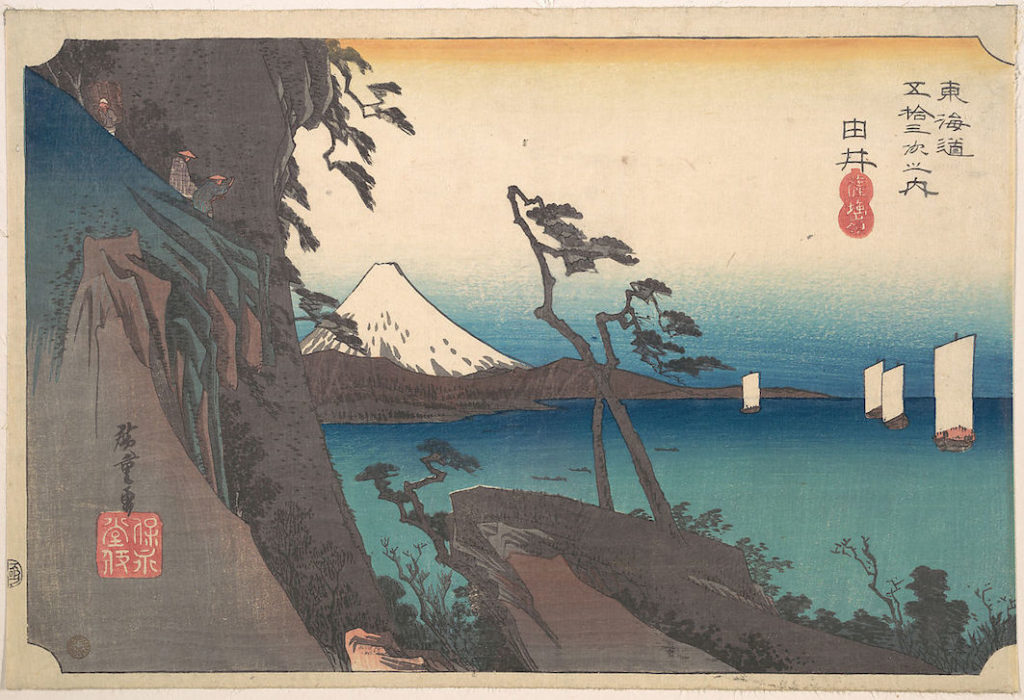 Satta Peak At Yui (1834) by Utagawa Hiroshige.
Satta Peak At Yui (1834) by Utagawa Hiroshige.
Image credit: The Metropolitan Museum of Art
An important road since ancient times and especially during the Edo period, the Tōkaidō was an indispensable route that connected the new capital of Tokyo to Kyoto.
The route is depicted in one of Utagawa Hiroshige’s best-known series, The Fifty-Three Stations of the Tōkaidō. One of the woodblock prints from the series, Satta Peak at Yui, depicts the 16th station of the ancient route.
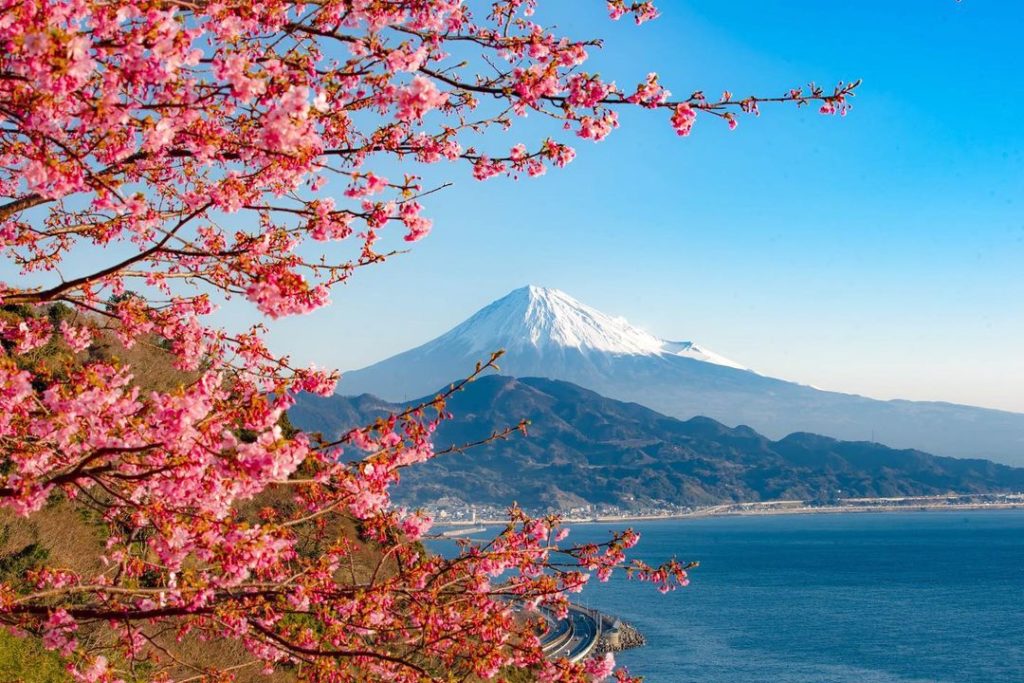
Image credit: @douce_vie._.85
Formerly known as Yuishuku (由比宿), the Satta Pass Observation Deck has gone through radical changes. Most noticeably, the steep treacherous mountain path pictured in the woodblock print has given way to modern highways. Today, the former station provides a scenic spot that overlooks the Suruga Bay, the surrounding Izu Peninsula, and an impressive view of Mount Fuji.
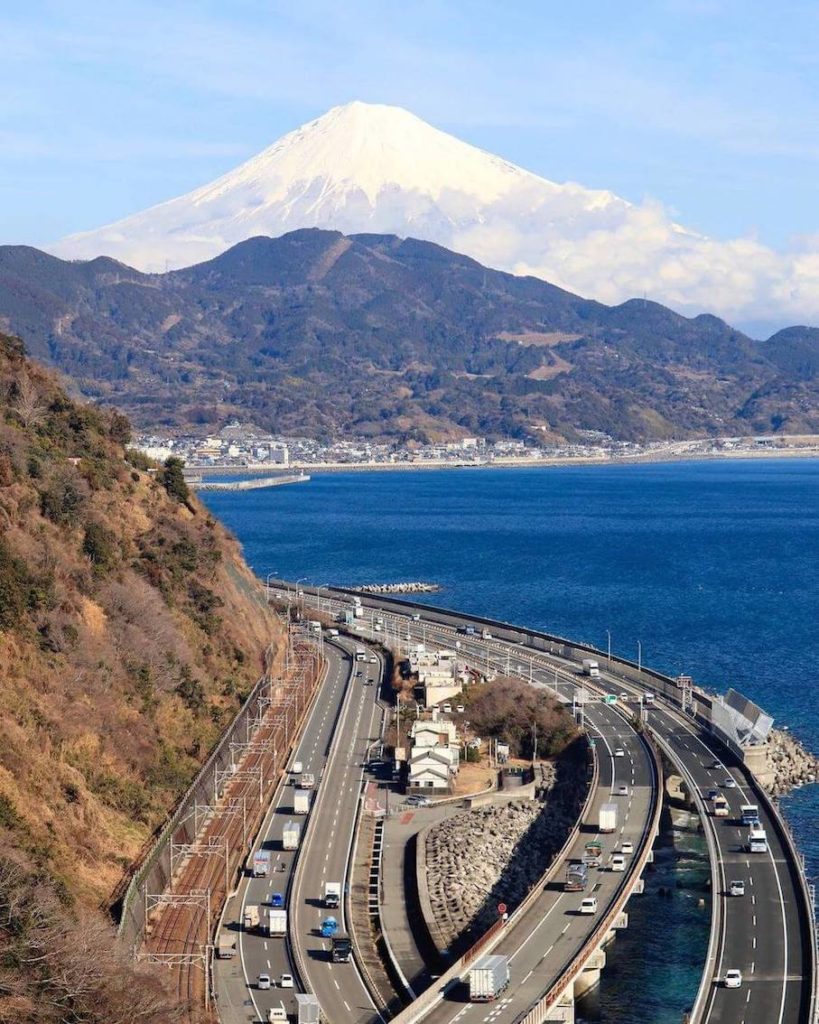
Image credit: @momo_m0220
To catch a glimpse of the splendid view, you can trek for approximately 50 minutes from either JR Okitsu Station or JR Yui Station. Alternatively, the city of Shizuoka has also kindly provided detailed directions for those commuting by car.
Satta Pass Observation Deck
Address: 937-13 Yuinishikurasawa, Shimizu Ward, 421-3115, Shizuoka
Opening hours: 24 hours, Daily
5. Under Mannen Bridge at Fukagawa
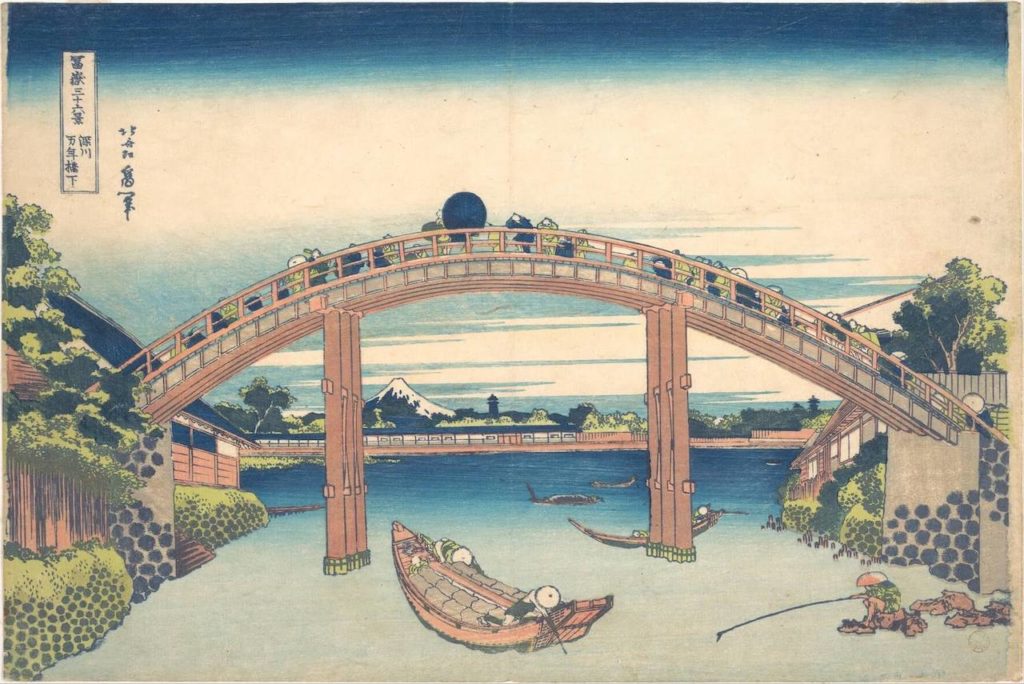
Under The Mannen Bridge at Fukagawa (1830-1832) by Katsushika Hokusai.
Image credit: The Metropolitan Museum of Art
Comprising 46 woodblock prints, the series Thirty-Six Views Of Mount Fuji captures the magnificent beauty of Mount Fuji from various angles and regions. Popular designs were reprinted multiple times during its time, and the series remains well-received today. In fact, several designs from the series were even used in the packaging for potato chips.
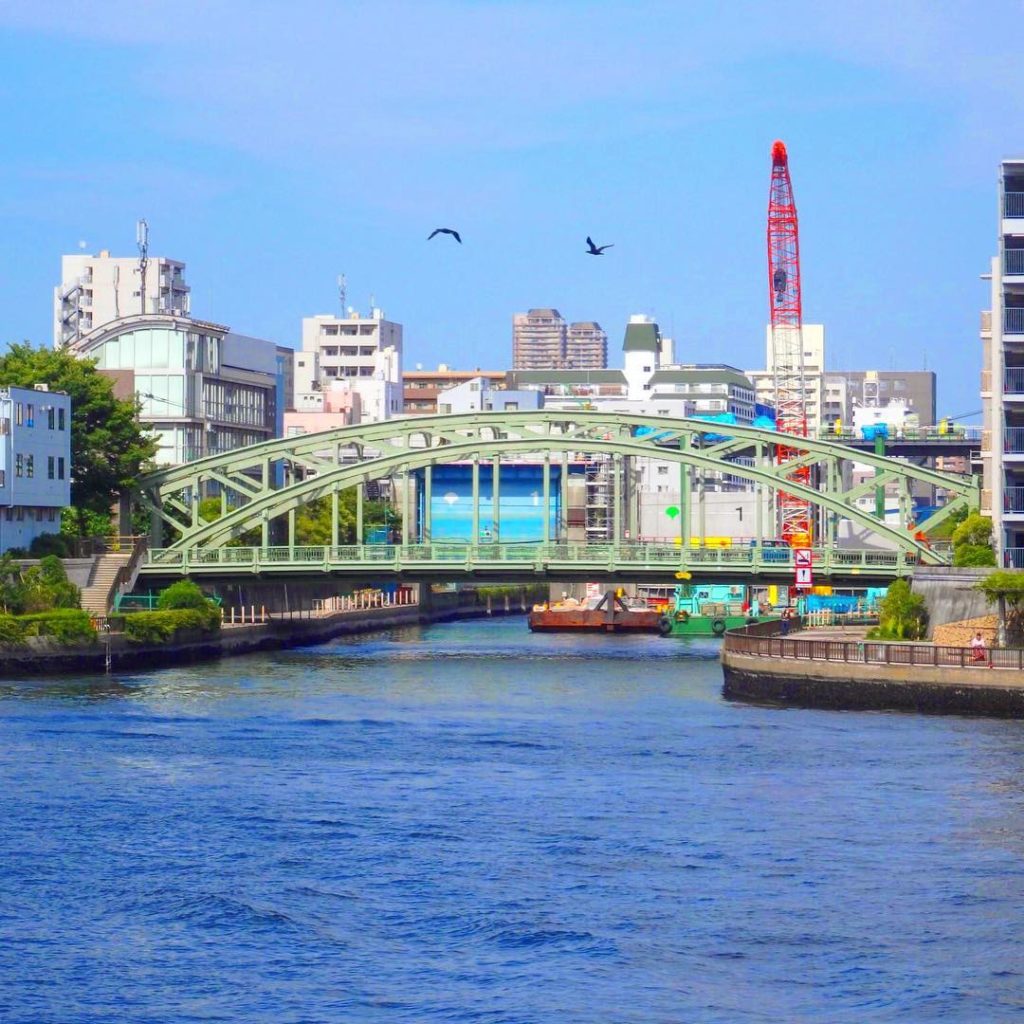
Image credit: @kome0193
The prolific ukiyo-e artist Katsushika Hokusai is best known for his famed The Great Wave Off Kanagawa, but there are plenty of other noteworthy woodblock prints from the same series. In particular, Under The Mannen Bridge at Fukagawa features the titular Mannen Bridge, boasting bustling human activity during the Edo Period.
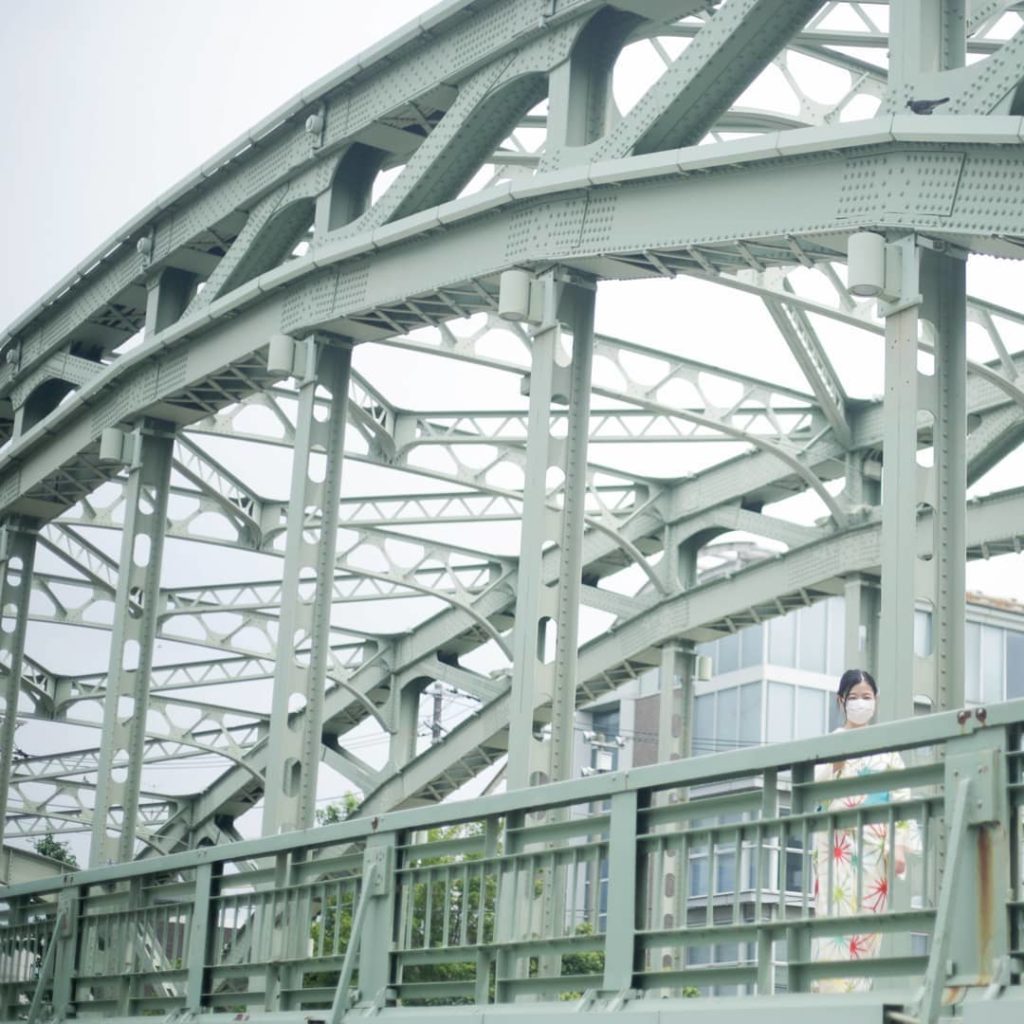
Image credit: @hands__and__feet
The curved bridge stretches across Onagi River, which was frequently used back then to transport fresh produce and salt from Gyōtoku, a former district in the south of Ichikawa, in Chiba Prefecture.
Built with elevated pillars to avoid obstructing passing ships, Mannen Bridge was well-loved for its height and size. If you look closely, you’d be able to spot the iconic Mount Fuji in the backdrop of the print.
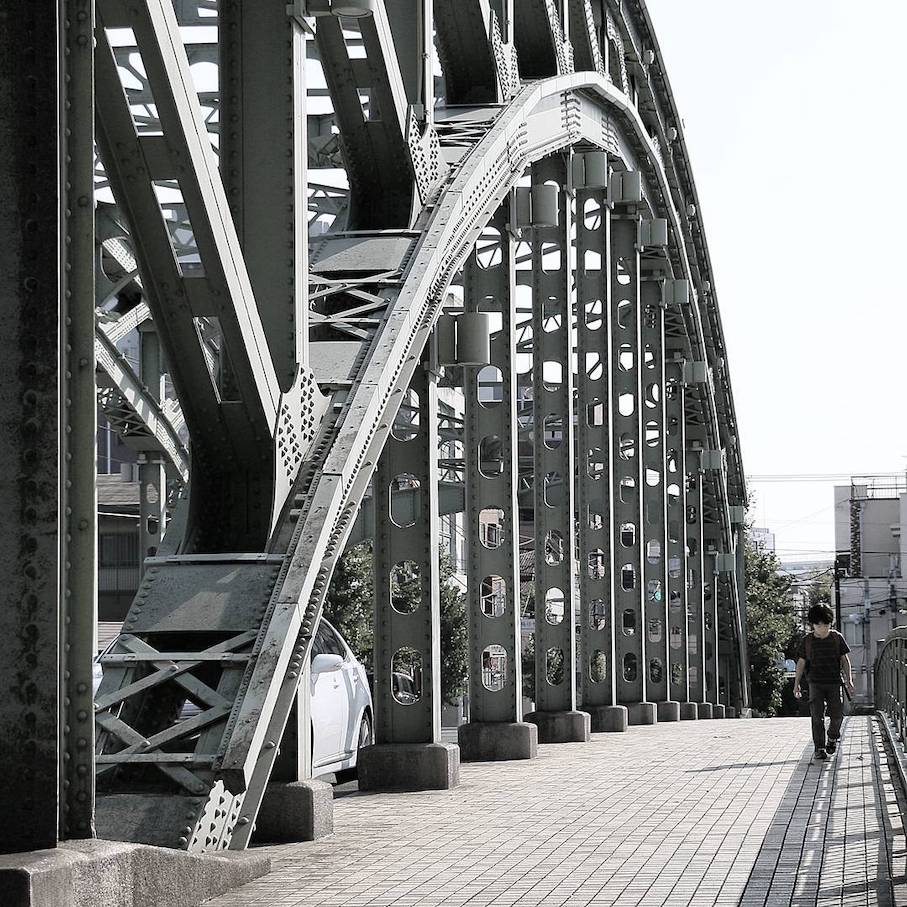
Image credit: @heron0217
The Mannen Bridge in Hokusai’s print gave way to a newer bridge in 1930, but it still retains the signature arched design of the old wooden bridge.
Mannen Bridge
Address: 2 Chome-14-9 Kiyosumi, Koto City, 135-0024, Tokyo
Opening hours: 24 hours, Daily
6. Mariko: Famous Tea Shop
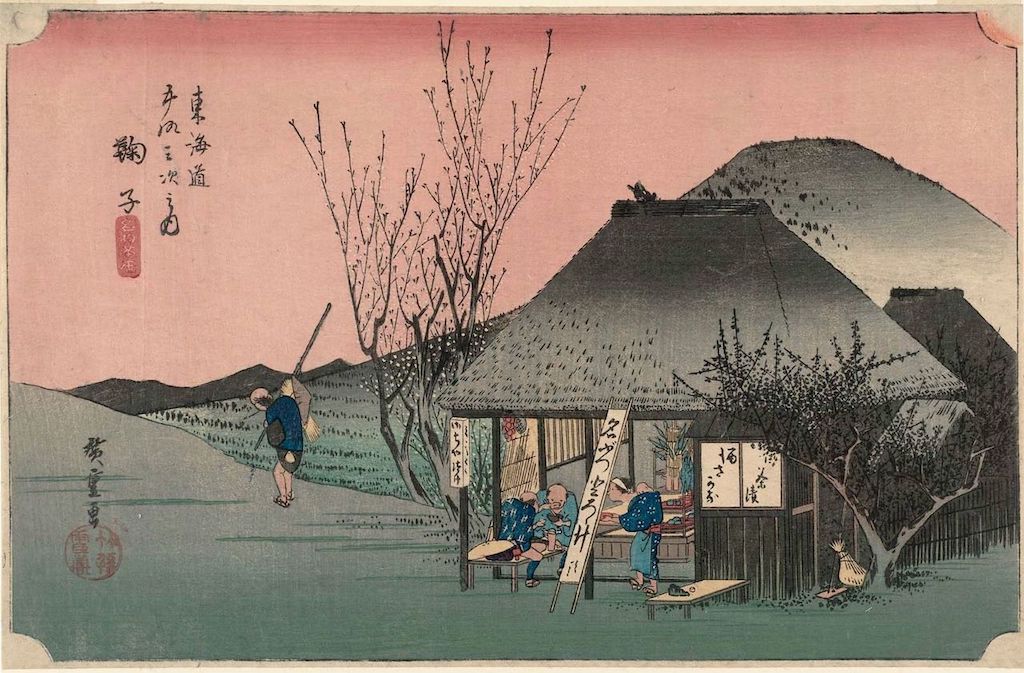
Mariko: Famous Tea Shop (1833-1834) by Utagawa Hiroshige.
Image credit: Ukiyoe.org
Another woodblock print from Utagawa Hiroshige’s The Fifty-Three Stations of the Tōkaidō, Mariko: Famous Tea Shop portrays the 20th post station of the Tōkaidō road. During the Edo period, religious pilgrimages to shrines and temples became popular. Rest stops like Chojiya in Mariko, a post town, were frequented by exhausted travellers.
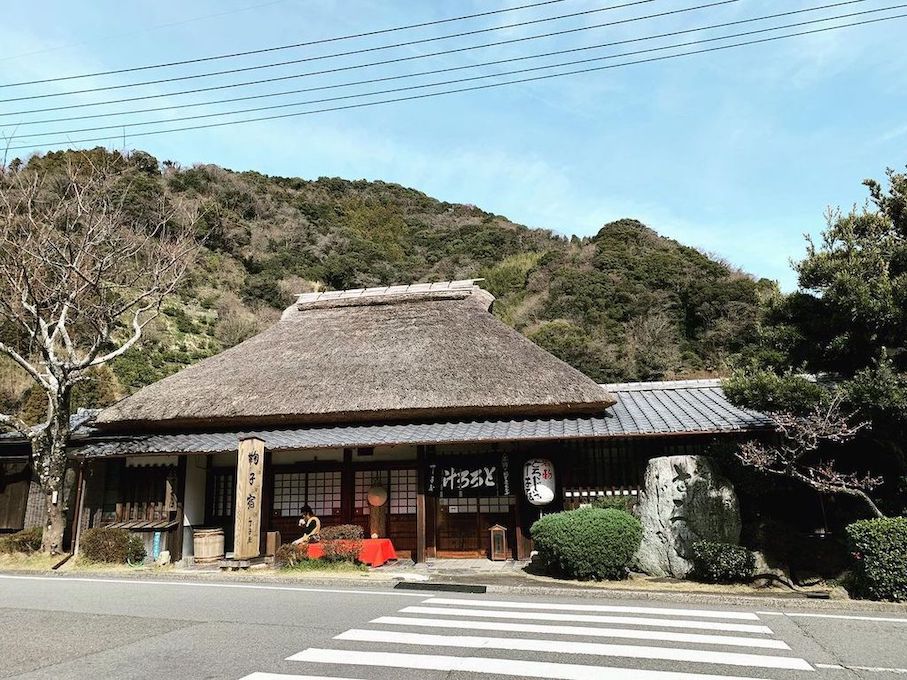
Image credit: @nonononono1717
Founded in 1596, the humble restaurant Chojiya has been serving up comfort food and simple fares to tired travellers for over 400 years. They specialise in tororo-jiru (薯蕷汁; Japanese grated yam soup) that’s made with locally sourced natural yam.
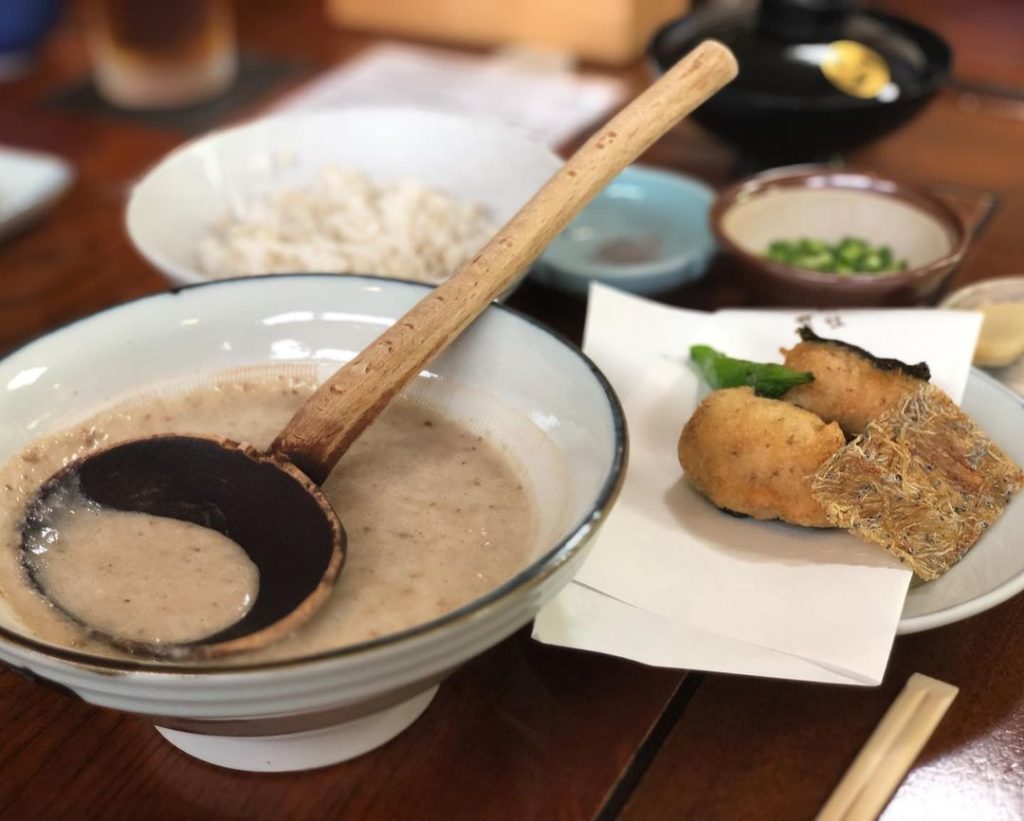
Image credit: @banmido3
Order their set meal (¥1,540, ~USD14.13), which comes with tororo-jiru, miso soup, barley rice, and pickled side dishes, to get a full taste of what the restaurant has to offer.
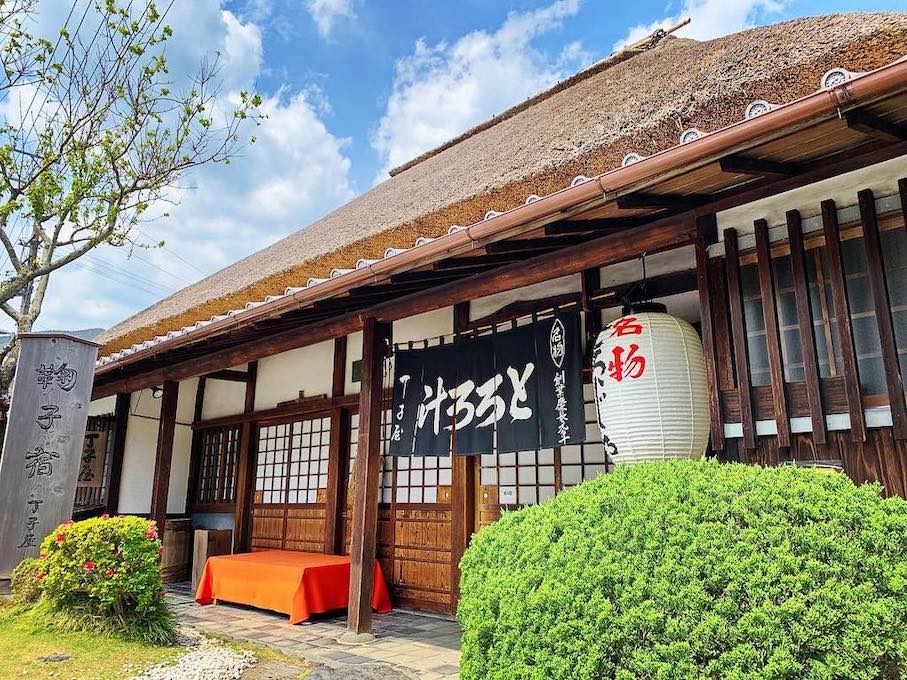
Image credit: @mv5fs
The interior is furnished with ukiyo-e prints and retains the appearance of an old folk house reminiscent of the Edo period, transporting customers into the realm of Hiroshige’s artwork. Customers can also browse through a gallery that houses actual tools used by travellers from the past, as well as a selection of prints by Hiroshige.
Chojiya
Address: 7 Chome-10-10 Mariko, Suruga Ward, 421-0103, Shizuoka
Opening hours: Mon – Fri 11AM-2PM (Closed on Thursdays and last Wednesday of the month) | Sat, Sun & Public Holidays 11AM-3PM & 4.30PM-7PM
Telephone: 0542-58-1066
Website
7. Enoshima in Sagami Province
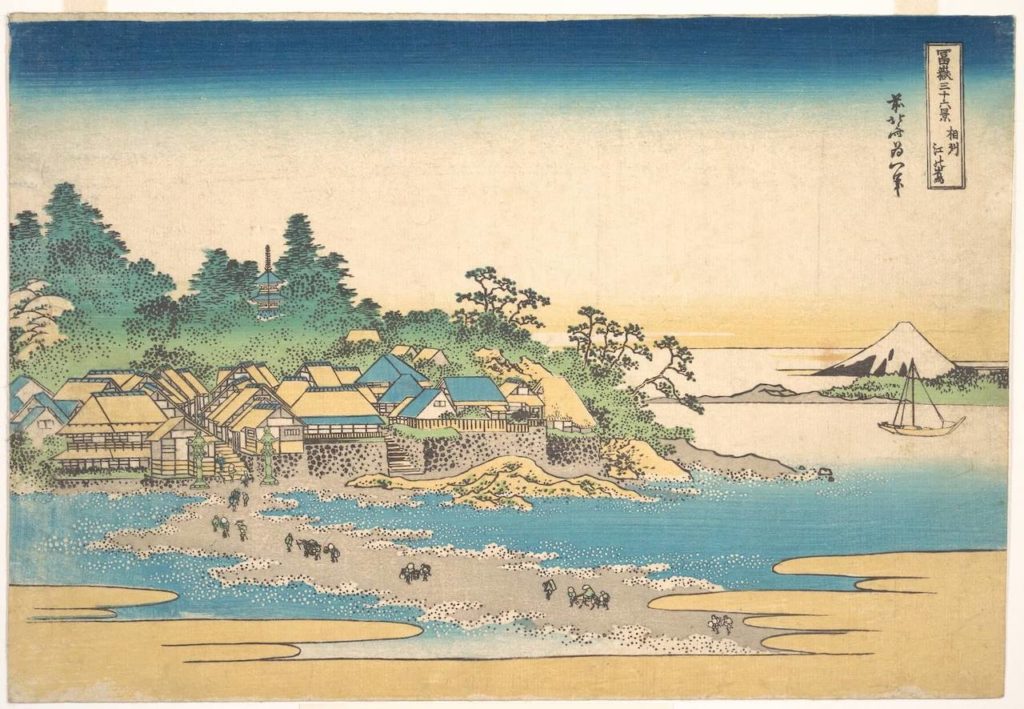
Enoshima in Sagami Province (1830-1832) by Katsushika Hokusai.
Image credit: The Metropolitan Museum of Art
As part of Hokusai’s Thirty-Six Views Of Mount Fuji series, Enoshima in Sagami Province immortalises the coastal view of both Enoshima and Mount Fuji. The view that’s seen from Shichirigahama, a beach situated in west Kamakura, served as a popular subject for ukiyo-e artists.
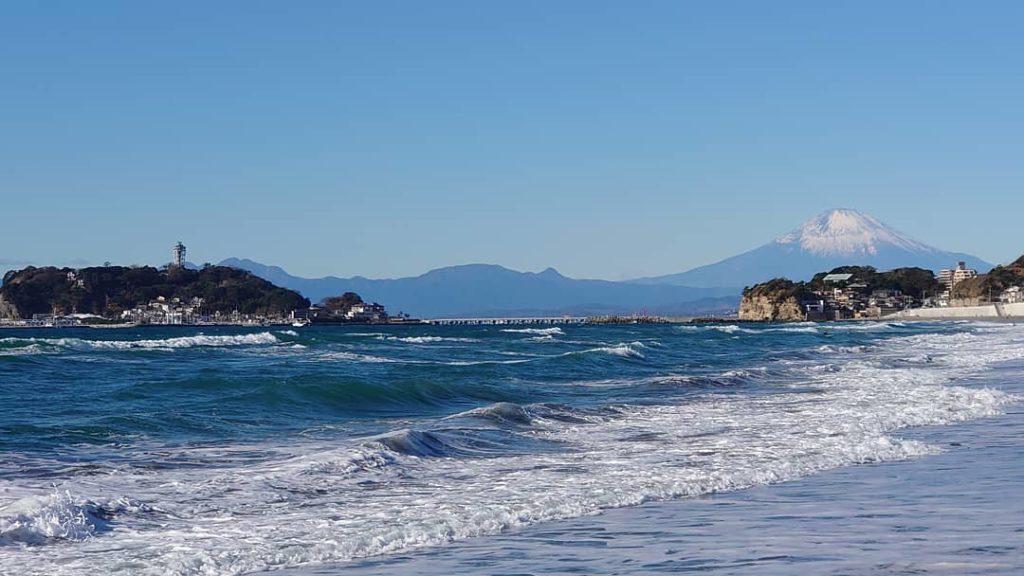
Image credit: @takashimollys
During the Edo period, Enoshima was regarded as a site of worship as many believed that the island enshrines Benzaiten, a Buddhist goddess. Citizens of Edo would walk on the sightseeing path – a sandy path that emerged at low tide – that connected Enoshima and Kamakura.
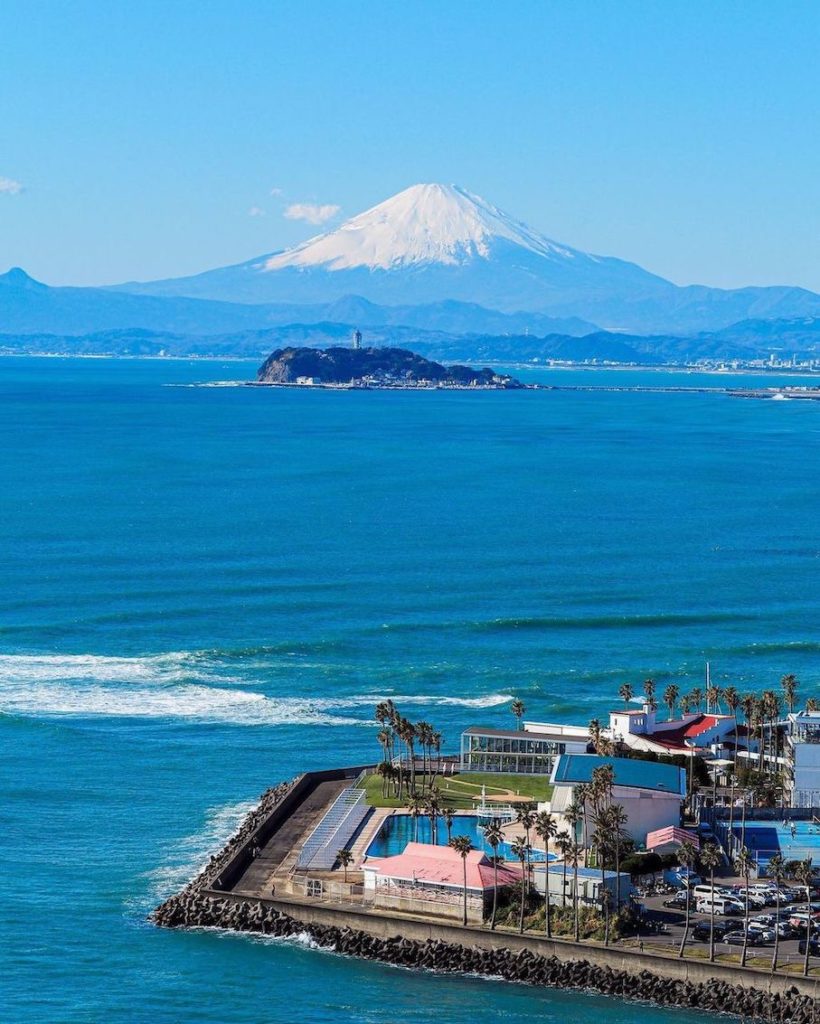
Image credit: @yuki__hamakko
On a clear day, you’d be able to catch a glimpse of Enoshima and the spectacular view of Sagami Bay that inspired the woodblock print.
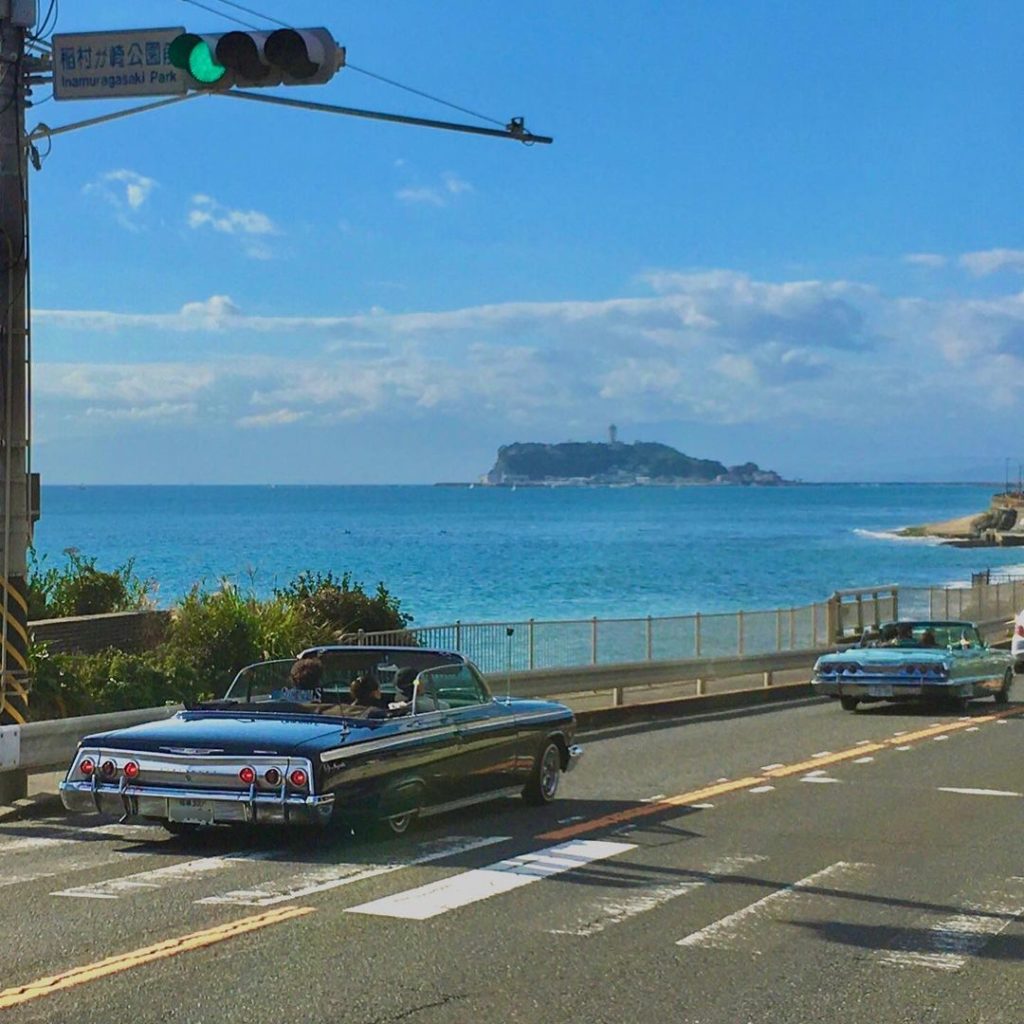
Image credit: @farm_292
These days, Shichirigahama is a hot spot for surfing enthusiasts as it has great waves for surfers to catch. A vast coast which stretches about 2.9km, Shichirigahama is especially popular among Tokyoites who are looking for a short weekend getaway to escape from the stress of city life.
Shichirigahama
Address: Shichirigahama, 2-chōme-1 Shichirigahama Higashi, Kamakura, 248-0025, Kanagawa
Opening hours: 24 hours, Daily
8. Amanohashidate in Tango Province
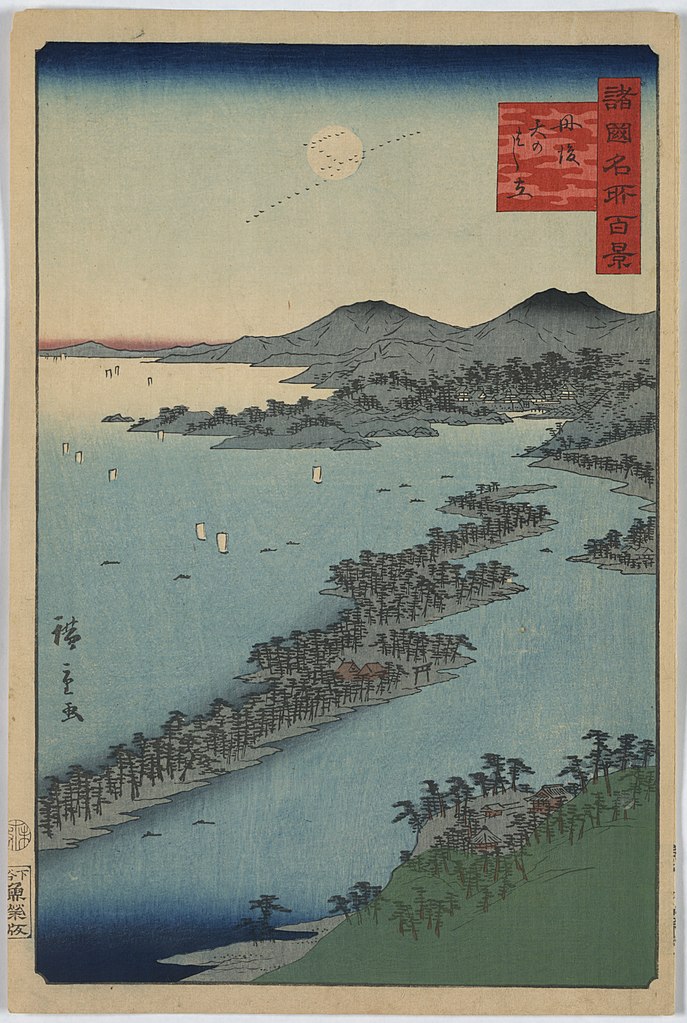
Amanohashidate in Tango Province (1859) by Utagawa Hiroshige.
Image credit: Wikimedia Commons
Voted as 1 of the “3 Most Scenic Places In Japan” (日本三景; nihon sankei), Amanohashidate is a gorgeous sandbar located just 2 hours from Kyoto Station. Spanning 3.6km in length and clad in pine trees, the sandbar is as spectacular today as it was when it was illustrated in Hiroshige’s woodblock print, Amanohashidate in Tango Province.
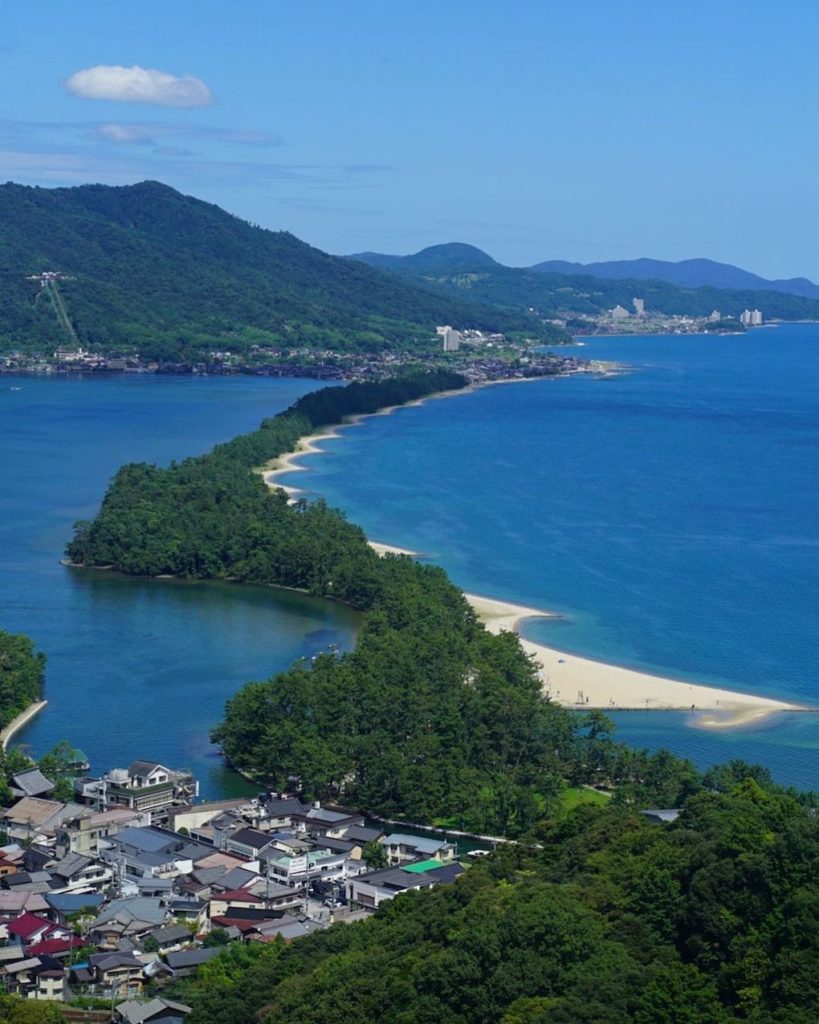
Image credit: @arine1202
The name “Amanohashidate” (天橋立), which loosely translates to “a floating bridge in the sky”, is said to be derived from an ancient myth. Izanagi, an ancient deity in Japanese mythology, used a bridge to descend from heaven to earth in order to meet his sister and wife, Izanami. Legend has it that while Izanagi was taking a nap one day, the bridge collapsed, hence forming Amanohashidate.
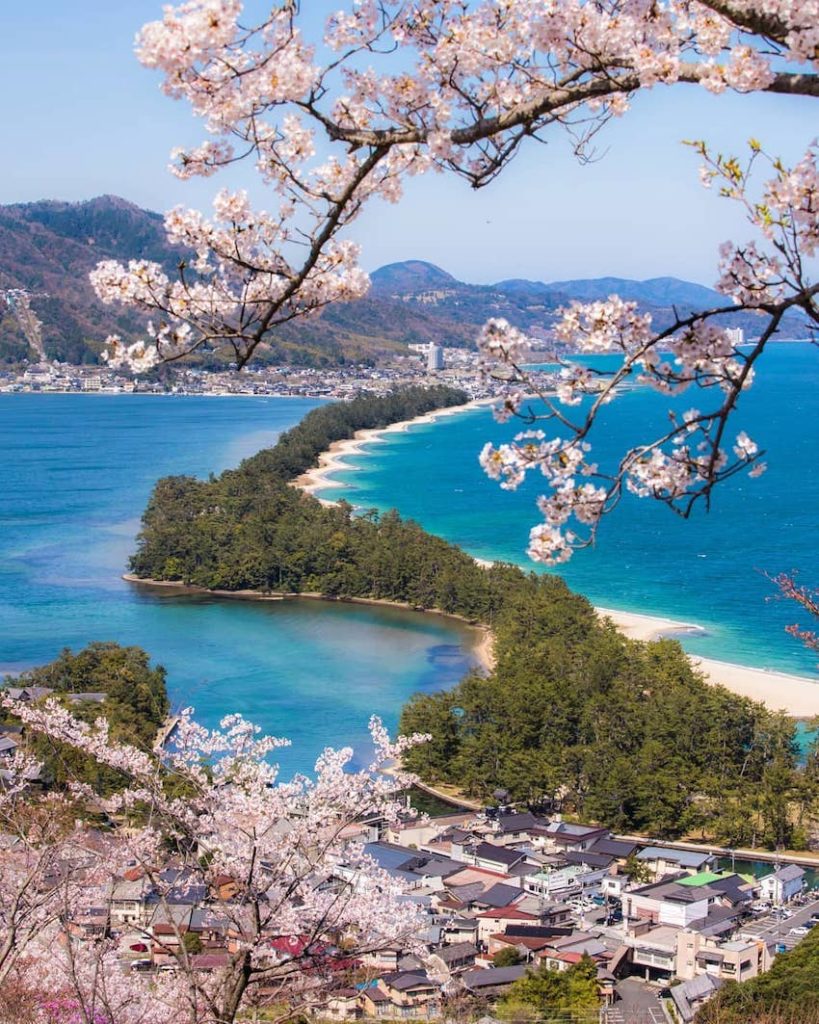
Image credit: @sora1836
There are 4 observatory decks where you can admire picturesque views of Amanohashidate, but the 2 most popular ones are at Amanohashidate View Land and Kasamatsu Park.
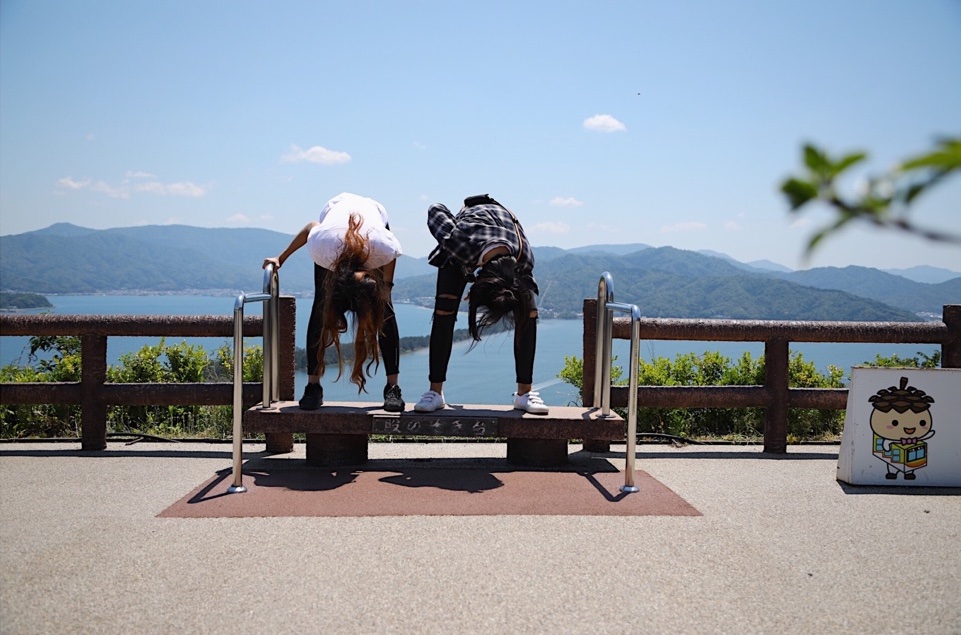
Matanozoki
Image credit: Xiu Ting Wong
Once you’ve reached the viewing points, make sure to give the customary matanozoki (股のぞき) a go. Turn your back on the view, bend over, and admire the sandbar through your legs. When viewed upside down, the pine-tree covered sand bay resembles a majestic dragon flying in the sky.
Amanohashidate
Address: Miyazu, Kyoto
Opening hours: 24 hours, Daily
Website
9. Kyoto: The Great Bridge at Sanjō
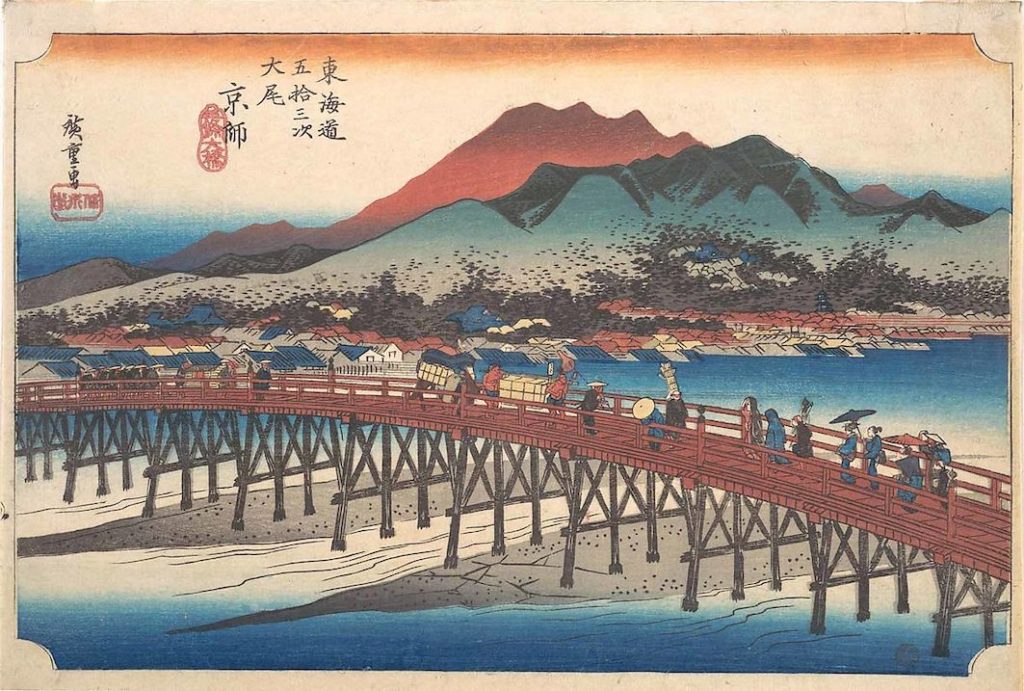
Kyoto: The Great Bridge at Sanjō (1833-1834) by Utagawa Hiroshige.
Image credit: The Metropolitan Museum of Art
In Hiroshige’s The Fifty-Three Stations of the Tōkaidō, Kyoto: The Great Bridge at Sanjō marks the end of the Tōkaidō route and the arrival in Kyoto. Standing on the Sanjō Ōhashi bridge, which is stretched across Kamo River, the traveller can finally take a breather as the arduous 500km journey across the Tōkaidō is finally over.
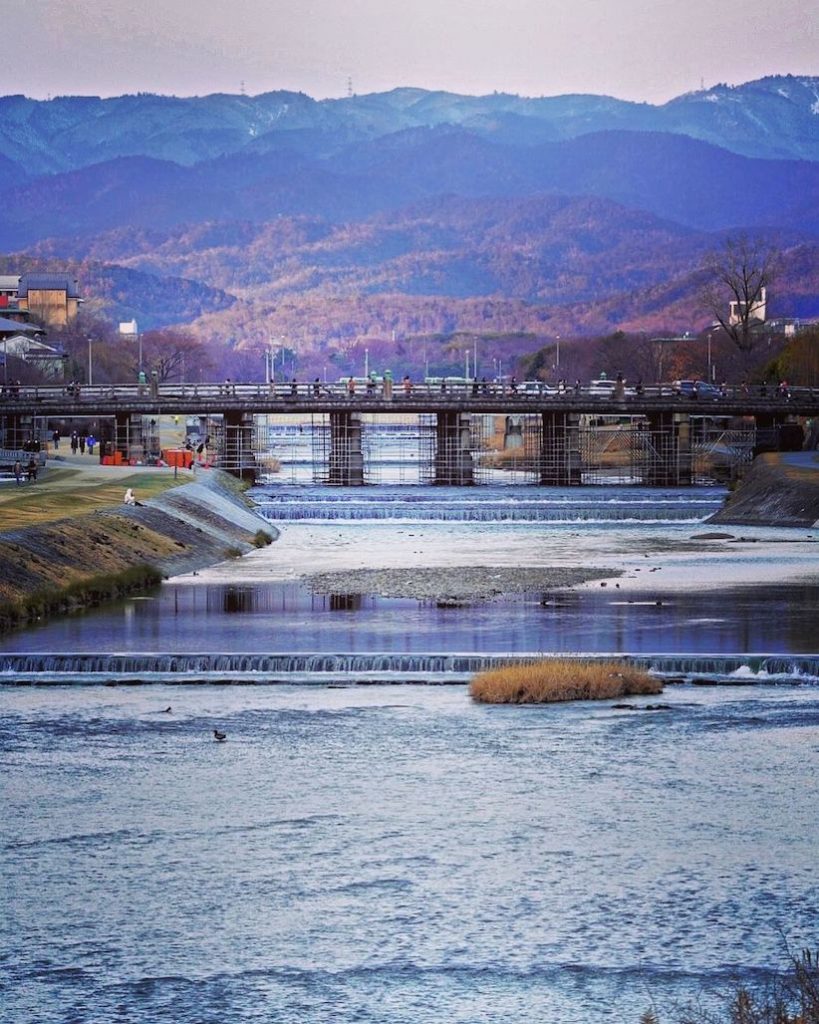
Image credit: @c_c_koogram
Set against the mountainous backdrop of Higashiyama, the print depicts the liveliness of the former imperial capital as weary travellers and locals cross the bridge. Today, its surroundings have transformed drastically. But the bridge is still abuzz with activity and excitement as both locals and tourists alike go on with their daily lives.

Image credit: @hino0117
Take a leisurely stroll along Kamo River, which runs through the bridge, or just sit along the riverbank and people–watch.
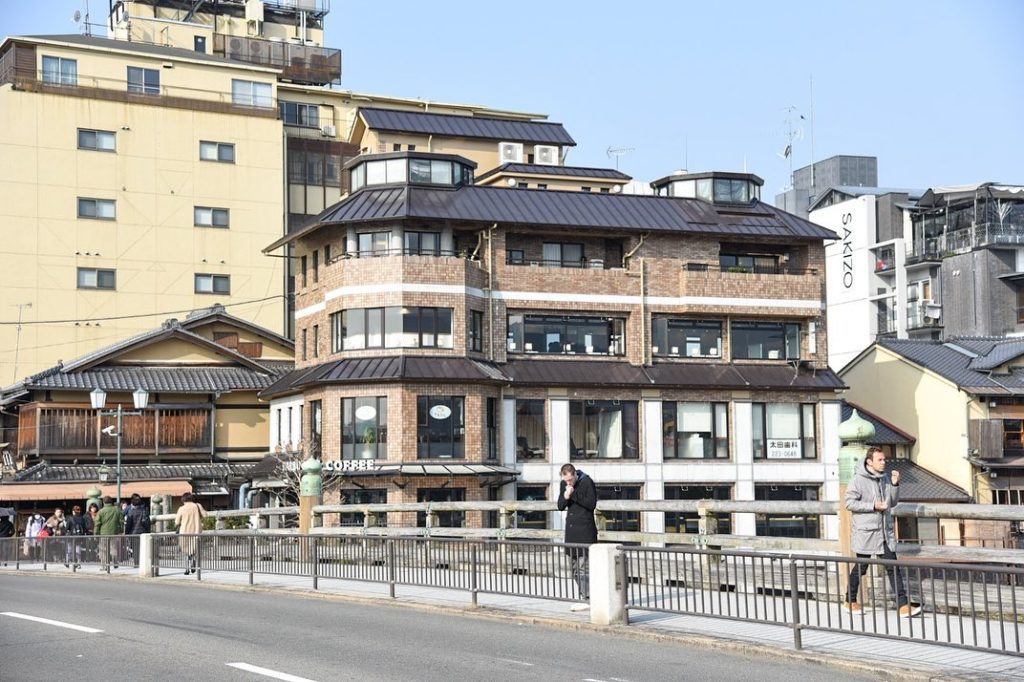
Image credit: @36_kyotosnap
In the summer, the area comes alive at night. Shops and restaurants that are lined up along the riverbank set up open-air decks, better known as noryo yuka (納涼床; wooden raised terrace), where customers can enjoy the summer evening breeze. Beautifully lit up at night, the atmospheric view of rows upon rows of noryo yuka can be best enjoyed from Sanjō Ōhashi.
Sanjō Ōhashi
Address: Sanjo Keihan Mae, Ohashicho, Higashiyama Ward, 605-0009 Kyoto
Opening hours: 24 hours, Daily
10. Fushimi Inari Shrine
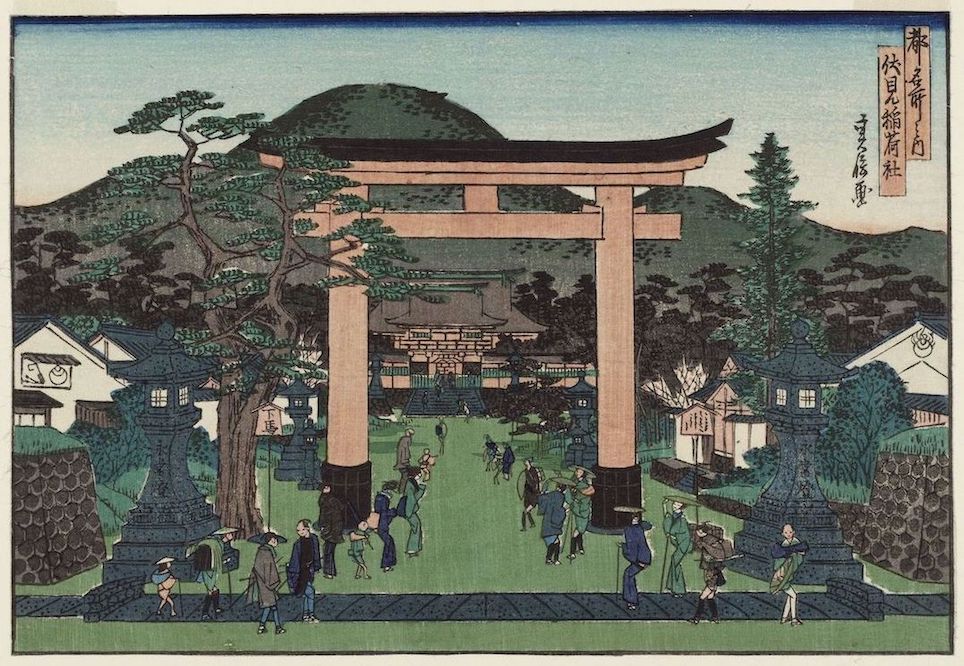
Fushimi Inari Shrine (1870-1871) by Hasegawa Sadanobu.
Image credit: Ukiyoe.org
It’s no surprise that one of the most celebrated shrines in Kyoto today inspired artists, such as Hasegawa Sadanobu, to create woodblock prints of the sacred spot. The landscape print (fūkeiga; 風景画) Fushimi Inari Shrine, which is part of the series Famous Places in the Capital, features the titular shrine and its torii gate entrance.
The famed shrine welcomes a steady flow of shrine goers who have come to pray for divine blessings. Though it’s more popular as a tourist attraction these days, pilgrims back then would visit the shrine every year to worship the god of Inari and pray for bountiful harvests, business prosperity, and more.
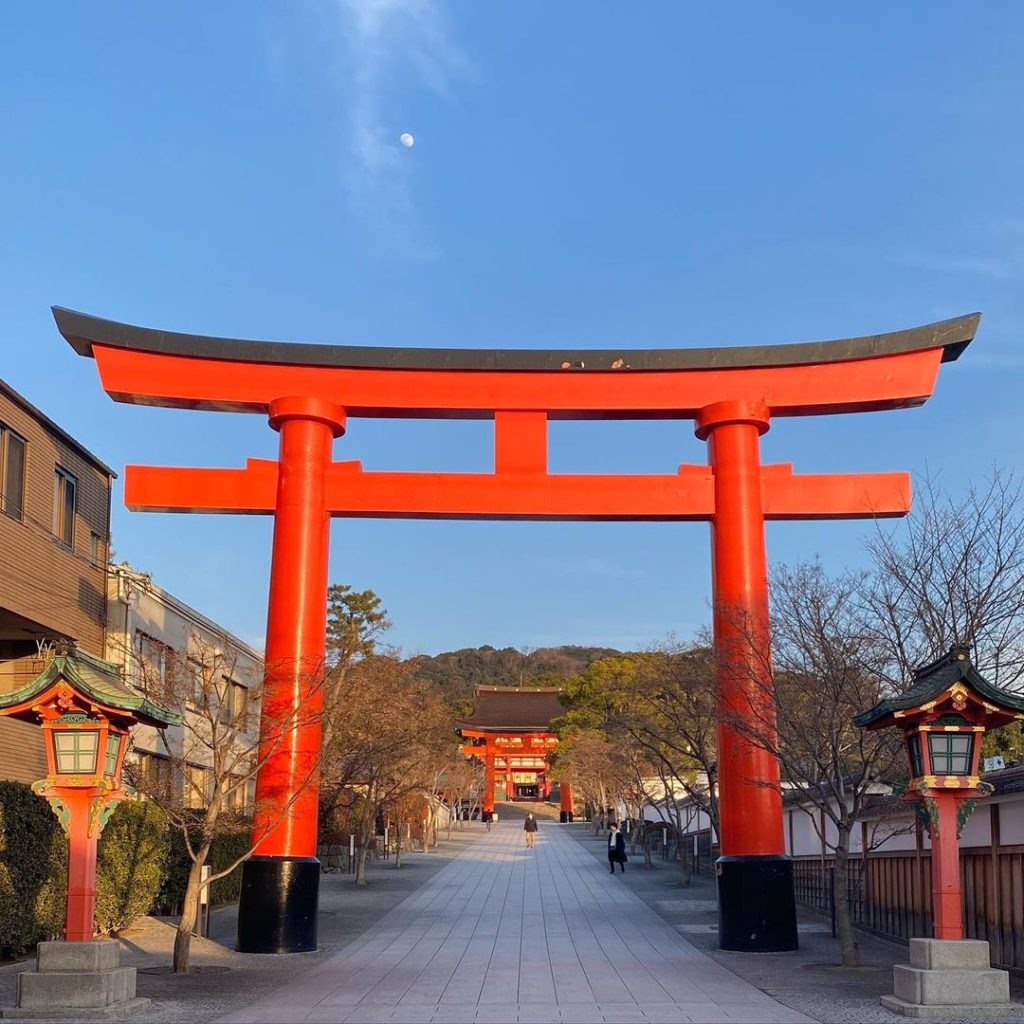
Image credit: @hiroshi__okabe
Though not pictured in this woodblock print, most visitors should be familiar with Fushimi Inari Shrine’s most memorable feature, the thousand vermillion torii gate-lined mountain paths.
It was a tradition that originated from the Edo Period – people who came here to pray often made donations to erect a torii gate to show their respect to the gods. Thus, an astonishing number of torii gates of varying sizes can be found throughout the premises.
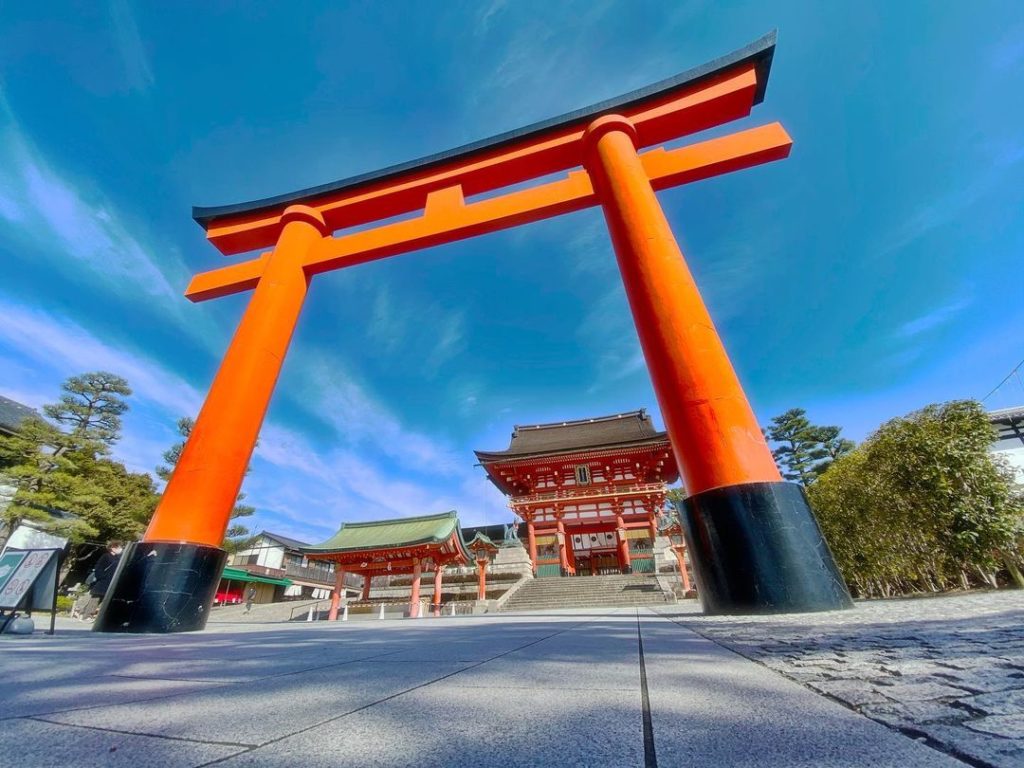 Image credit: @kre2_nkhr1
Image credit: @kre2_nkhr1
Upon passing through the 2 torii gates on the walkway approaching the main shrine, visitors will be greeted by the pictured towering Romon Gate (楼門), which is said to be built by Hideyoshi Toyotomi in 1589.
Fushimi Inari Shrine
Address: 68 Fukakusa Yabunouchicho, Fushimi Ward, 612-0882, Kyoto
Opening hours: 24 hours, Daily
Telephone: 0756-41-7331
Website
Japanese woodblock prints and their locations IRL now
Despite the fact that most Japanese woodblock prints were produced more than 200 years ago, many of the locations featured remain unchanged today. Take a trip to the spots depicted in famous ukiyo-e and see how much the surrounding scenery has evolved since it was first immortalised.
For more places to visit in Japan, check out:
- W Osaka: A flamboyant hotel with a minimalist exterior
- Oldest restaurants where iconic Japanese dishes were invented
- Stunning photos of Japan then and now
- IRL anime locations to visit in Japan
- Demon Slayer’s “Infinity Castle” IRL
Cover image adapted from: Wikipedia and @yumi.wada.3363
Enjoying The Smart Local Japan? Follow us on Facebook, Instagram, and Telegram for more articles like this.
